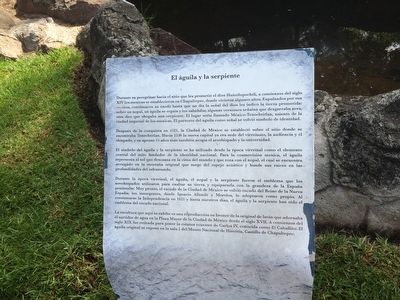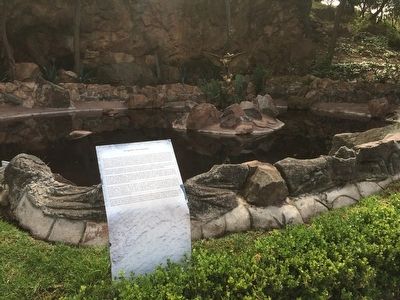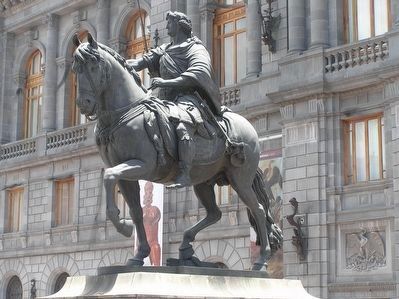Colonia Bosque de Chapultepec I Sección in Ciudad de México, Mexico — The Valley of Mexico (The Central Highlands)
The Eagle and the Serpent
El Águila y La Serpiente
Durante su peregrinar hacia el sitio que les prometió el dios Huitzilopochtli, a comienzos del siglo XIV los mexicas se establecieron en Chapultepec, donde vivieron algunos años. Expulsados por sus vecinos, continuaron su éxodo hasta un día la señal de dios les indicó la tierra prometida: sobre un nopal, un águila se erguía y los saludaba; algunas versiones señalan que desgarraba aves, otra dice que ahogaba una serpiente. El lugar sería llamado México-Tenochtitlán, asiento de la ciudad imperial de los mexicas. El portento del águila como señal se volvió símbolo de identidad.
Después de la conquista de 1521, la Ciudad de México se estableció sobre el sitio donde se encontraba Tenochtitlán. Hacia 1536 la nueva capital ya era sede del virreinato, la audiencia y el obispado, y en apenas 15 años más también acogía el arzobispado y la universidad.
El símbolo del águila y la serpiente se ha utilizado desde la época virreinal como el elemento central del mito fundador de la identidad nacional. Para la cosmovisión mexica, el águila representa el sol que descansa en la cima del mundo y que roza con el nopal, el cual se encuentra arraigado en la montaña original que surge del espejo acuático y hunde sus raíces en las profundidades del inframundo.
Durante la época virreinal, el águila y la serpiente fueron el emblema que los novohispanos utilizaron para exaltar su tierra y equiparla con la grandeza de la España peninsular. Muy pronto, el escudo de la Ciudad de México se volvió escudo del Reino de la Nueva España; los insurgentes, desde Ignacio Allende y Morelos, lo adoptaron como propio. Al consumarse la Independencia en 1821 y hasta nuestros días, el águila y la serpiente han sido el emblema del escudo nacional.
La escultura que aquí se exhibe es una reproducción en bronce de la original de latón que adornaba el surtidor de agua en la Plaza Mayor de la Ciudad de México desde el siglo XVII. A comienzos del siglo XIX fue retirada para poner la estatua ecuestre de Carlos IV, conocida como El Caballito. El águila original se expone en la sala 1 del Museo Nacional de Historia, Castillo de Chapultepec.
During their pilgrimage to the site that was promised to them by the god Huitzilopochtli, by the early fourteenth century the Aztecs (Mexica) settled in Chapultepec, where they lived for many years. They were expelled by their neighbors and continued their exodus until they saw a signal one day that told them they had reach the promised land. That signal was an eagle
sitting on a cactus, waving to the Mexica; some versions of the story say that the eagle was ripping up birds; another says that he was drowning a snake. The place would be called Mexico-Tenochtitlan, seat of the imperial city of the Aztecs. The eagle came to represent a symbol of the city's identity.
After the conquest of 1521, Mexico City was established on the site of Tenochtitlan. In 1536 it was the new capital and the seat of the viceroy, the Royal Court and the bishop. In just 15 years it also welcomed the archbishop and the university.
The symbol of the eagle and the snake has been used since the colonial era as the central element of the foundation myth of national identity. In the Mexica worldview, the eagle represents the sun resting on top of the world, while touching against the nopal cactus. The cactus is rooted in the original mountain that emerges from the mirror made of water and is itself rooted in the depths of the underworld.
During the colonial era, the eagle and the snake were the emblem that New Spain used to represent their land and attempt to give it the same grandeur as mainland Spain. Soon, the seal of the City of Mexico became the seal of the Kingdom of New Spain; insurgents such as Ignacio Allende and Morelos also adopted it as their own. From Independence in 1821 until today, the eagle and the snake have been the emblem of the nation.
The
sculpture exhibited here is a bronze reproduction of the original brass sculpture that adorned the fountain in the Plaza Mayor (Zócalo) of Mexico City starting in the seventeenth century. In the early nineteenth century it was removed to make space for the equestrian statue of Charles IV, known as El Caballito (The Little Horse). The original eagle statue is in Hall 1 of the National History Museum, Chapultepec Castle.
Topics. This historical marker is listed in these topic lists: Colonial Era • Native Americans • Settlements & Settlers • Wars, Non-US. A significant historical year for this entry is 1521.
Location. 19° 25.175′ N, 99° 11.037′ W. Marker is in Ciudad de México. It is in Colonia Bosque de Chapultepec I Sección. The marker and statue are on the left traveling up the walkway to the Chapultepec Castle and Museum of National History, past the locker area. Touch for map. Marker is in this post office area: Ciudad de México 11100, Mexico. Touch for directions.
Other nearby markers. At least 8 other markers are within walking distance of this marker. José María Morelos y Pavón (within shouting distance of this marker); Gallery of History (about 90 meters away, measured in a direct line); Fernando Montes de Oca, Child Hero of Mexico (about 150 meters away); The March of Loyalty (about 210 meters away); The Military College of Mexico (about 240 meters away); Francisco Marquez, Child Hero of Mexico (approx. 0.2 kilometers away); The Large and Small Lakes at Chapultepec (approx. 0.2 kilometers away); Ahuehuetes of Chapultepec (approx. 0.3 kilometers away). Touch for a list and map of all markers in Ciudad de México.
Credits. This page was last revised on April 17, 2020. It was originally submitted on December 3, 2015, by J. Makali Bruton of Accra, Ghana. This page has been viewed 418 times since then and 14 times this year. Photos: 1, 2. submitted on December 3, 2015, by J. Makali Bruton of Accra, Ghana. 3. submitted on December 4, 2015, by J. Makali Bruton of Accra, Ghana.


